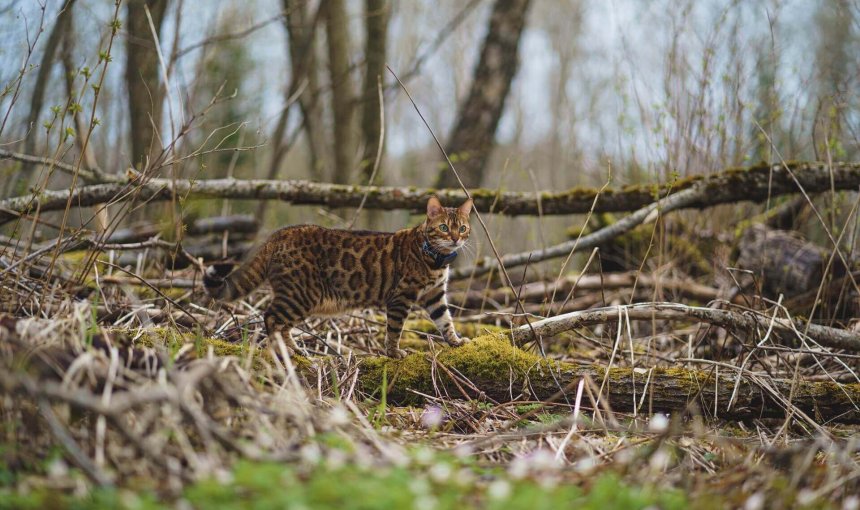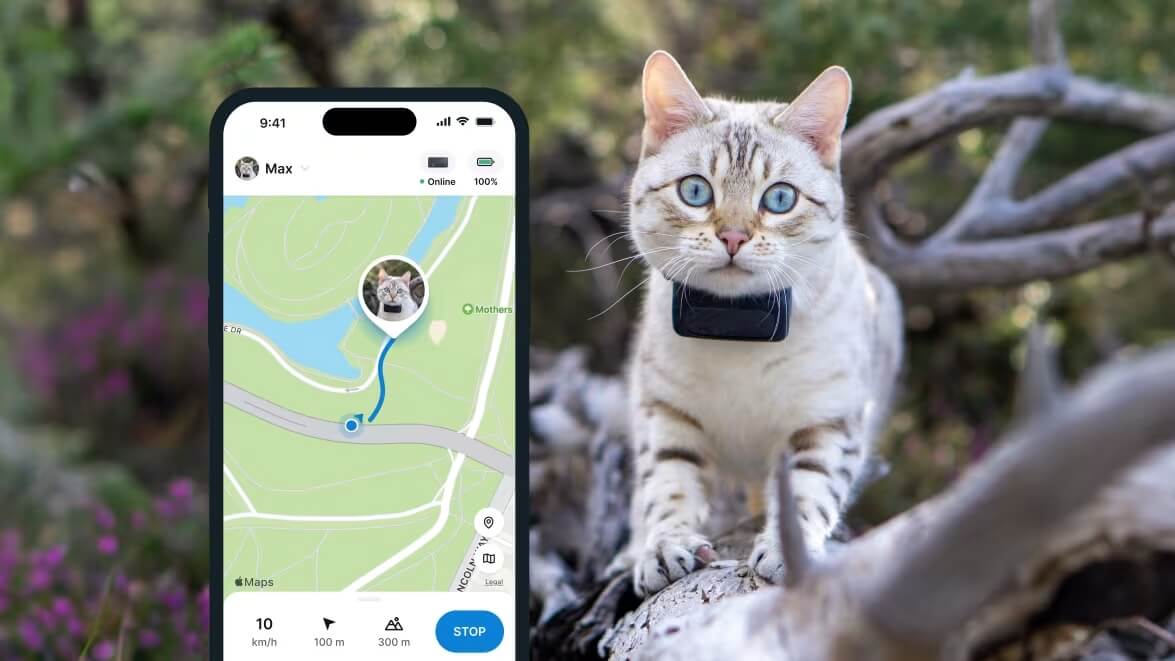Cat Territory Size & Range: How Far Does Your Cat Roam?
Maintaining a territory is a trait common to all cats, both wild and domestic - indoors and outdoors! But with all the dangers that come with the outdoors, how do you keep your wandering cat safe on their adventures?

Whether you’ve got an indoor cat, outdoor cat…or an indoor-outdoor cat – you can bet your home, home office, backyard, or even the neighborhood park is officially cat territory. Which makes sense for outdoor cats who seem to wander the earth and return home when they feel like it. (Mostly for food.) But turns out, even Mr. Muffykins curled up under your couch counts your apartment as “theirs” – even if they aren’t paying rent. But why do cats have territory – and how can you keep them safe when they’re out patrolling theirs?
Key Takeaways
The size of your cat’s territory depends on factors like whether they’re an indoor or outdoor cat and if they need to hunt for food.
Using a smart collar like the Tractive GPS tracker is a great way to help prevent a lost cat situation, as it allows you to track your cat in real time, map their territory, and set up virtual fences for safety.
Beyond a GPS tracker, other important safety measures for your cat include getting them microchipped and considering spaying or neutering to reduce their urge to roam.

Find out where your cat spends their time.
Read more- Cat territories & ranges: What are they?
- Why are cats territorial?
- Why it makes sense to know your cat’s territory
- Types of cat territories
- How does this affect the way I care for my cat?
- Multi-cat homes & their territories
- Outdoor cat & feral cat territories
- Cat territory size: When it can become a safety concern
- How to keep your cat safe – throughout their territory
- Where a smart cat collar works as an emergency measure
Cat territories & ranges: What are they?
A cat’s territory is the area that it will defend against intruders. (Aka, most likely other neighborhood cats, dogs, or wildlife.) A cat’s range includes all the places that it travels to. So, if your cat is allowed to roam freely outdoors, their territory may be your backyard. Your kitty’s range may include your backyard, a few neighboring yards, and a local park, too. And some of this range may overlap with another cat’s territory. (Which might lead to some nasty turf wars down the line, if you aren’t monitoring your cat’s whereabouts.)
💡Which is where a smart cat collar with real-time GPS tracking can be an important emergency measure. Now, you can track your cat’s every step, across their territory, in real-time. So you can intervene if you notice them wandering anywhere dangerous or just too far from safety.
Why are cats territorial?
Because of a combination of instincts and lifestyle. All cats – wild, domesticated, semi-domesticated, indoor, outdoor, and indoor-outdoor – are territorial. However, a solo indoor cat with regular meal times and toys at home might not be as territorial as say, an outdoor cat that’s used to roaming their neighborhood.
To maintain a territory, your cat must patrol it, scent mark the borders, and defend it against trespassers. (Especially other cats.) Which is why outdoor domestic cats will have larger ranges than indoor cats. Feral cats (which have little or no interaction with people) will have much larger territories, because they must find or hunt for their own food.

Track your cat wherever they go
Get real-time location information, wherever they go. Find out when they go somewhere they shouldn’t, with Virtual Fences. And discover their favorite spots with Territory.
Why it makes sense to know your cat’s territory
According to researchers at the University of California-Davis, indoor cats may live between 15-17 years. On the other hand, purely outdoor cats might only live 2-5 years. Unless, of course, you’re taking precautions and are staying on top of their safety.1 Your cat’s immediate territory might not include any threats – unless you’ve checked and double-checked for:
- Aggressive pets at your neighbors’
- Neighborhood dumping grounds, which might include foods harmful to cats
- Poisonous plants – in your backyard and elsewhere in your cat’s territory
- Areas where residents might’ve used harmful substances like pesticide
- Pet thieves, who might be lurking around every corner
- Densely forested areas where your cat might roam off to hunt – and get lost in
- …and the never-ending list of dangers your cat might face while roaming around outdoors.
😺 Pictured here is a cat’s territory outlined (in yellow) on the Tractive GPS pet tracking app. So you can better understand where your cat likes to wander off and prevent them from wandering too far.

Types of cat territories
Cat territories fall into a few general categories and vary in size depending on the cat’s indoor or outdoor lifestyle.
- A core territory is a place where cats feel safe and secure. Activities like sleeping or toileting, when a cat is vulnerable to attack, usually take place in this core territory.
- A hunting territory may take a domestic cat farther afield. This territory is claimed by your cat as their hunting ground. (Where they search for mice, voles, birds, and other creatures to eat.)
- Shared or common territories are places that your cat is OK sharing with others. Including people, other cats, dogs, or other pets. An example of a shared territory could be your living room or your garden, where the whole family, including pets, hangs out together.
How does my cat claim their territory?
Your cat might claim territory by:
- “Marking” different objects – leaving natural pheromones around through scent glands on their cheeks, forehead, chin, and at the base of their tails. Which could apply to you, furniture, shoes, and other objects.
- Scratching objects with their front paws, which also contain scent glands. Outdoor cats might scratch tree trunks or wooden posts. To avoid having your indoor cat shred your sofa, provide a scratching post. Entice your kitty to use the post by rubbing catnip on it.
- Urine spraying, especially vertical surfaces such as shrubbery, fence posts, rocks, or tree trunks by raising their tails and releasing a horizontal burst of urine against the object.
Finally, to keep track of activity in their territory, cats patrol the boundaries of their space at least once a day, scent marking or scratching as needed. In case you thought kitty was just sleeping at home all day!
⚠️ At the same time, indoor urine spraying could mean that your cat is stressed or has a medical condition, like a urinary tract infection. If your cat sprays indoors, talk to your veterinarian about possible causes and solutions to this behavior. Medications or pheromone diffusers can help to calm a cat and reduce the urge to spray.
How does this affect the way I care for my cat?
Whether you like it or not: all cats will define and defend their territory in some way. (By rubbing against you or the furniture, scratching, urine spraying – or getting aggressive!)
For indoor-only cats, make sure that your kitty has plenty of appropriate opportunities to scratch or mark their territory, such as a cat tree or scratching pole. Some cats enjoy perching up high where they can view all the goings-on in their territory.
Likewise, make sure to tire out your cat with regular playtime – so they’ll be less likely to scratch around your house (or your neighbors’ begonias) as part of their territory.
Read more: How To Get A Cat To Exercise: Keeping Our Feline Friends Happy and Healthy
Multi-cat homes & their territories
If you have two or more indoor cats in your home, they may not be willing to share a territory…unless they’re siblings. Intact, outdoor male cats may tend to be more territorial, in general – or even wander longer distances to establish their territory. You may need to help define their separate territories and reduce fights if you notice your cats:
- Run away from each other
- Hiss at each other
- Sleep in separate areas
- Or try and act dominant over the other
Just remember: disputes between multiple cats in your home can lead to aggression or even scent-marking with urine as the cats try to define their own space. So you could, for example, feed them in separate locations and set out different litter boxes. Give each cat a safe, secure place to sleep – a little away from everyone else (including other pets.)
Outdoor cat & feral cat territories
If you own an outdoor cat or a kitty that explores the great outdoors for part of the day, your cat may encounter feral cats while they are out exploring. But what’s the difference between outdoor cats and feral cats?
| Outdoor cats | Feral cats |
| Are owned or cared for by someone. Look out for a collar with an ID tag. | Are not owned or cared by anyone. May not have any identification details. |
| Have regular human contact, likely being fed regularly and taken to the vet. They might even go indoors for some parts of the day. | May never have had contact with humans – and if so, it was minimal. May be afraid of people and don’t seek interaction. |
| Territories tend to be smaller than feral cats.’ A backyard garden or deck may be enough. (So a few acres.) | Large territories, since these cats must hunt and find their own food. (Ranging from 2-1000+ acres.) |
Cat territory size: When it can become a safety concern
The average male outdoor cat may have a territory of a few acres, while a female’s may be much smaller. Some studies show that cats walk a few dozen yards to more than half a mile per day. But that said, the size of cats’ territories can vary widely depending on the environment, the availability of food, and your cat’s reproductive status. Your outdoor kitty roams up to a mile away from home. A cat’s daily travels are dictated by roads, fences, gates, or other animals in the neighborhood that they wish to avoid, such as a big dog.
However, a pet cat – whether outdoors full-time or indoor/outdoor – does not need to roam far because they do not need to hunt for sustenance. Likewise, domestic pet cats are also often spayed or neutered, so the urge to mate does not compel them to wander in search of a mate.
⚠️ But with all the reasons cats run away from home, it’s always worth it taking precautions to keep them 100% safe.
How to keep your cat safe – throughout their territory
Get your cat microchipped
⚠️ Approximately 71% of cats entering animal shelters end up being euthanized – because they’re more likely to enter a shelter without any sort of identification.2 Which is where it’s important to get them a a microchip cat ID that can help a vet or a local shelter identify you as the rightful owner.
Just remember: a microchip can’t actually track your cat in real-time. It’s only an identification device – not a pet tracker. That’s where a cat GPS tracker can help you figure out where your cat’s off wandering – with just a glance at your phone.
Ensure your cat is a “familiar face” in the neighborhood
When your cat is a familiar sight to your neighbors, they become part of the community. This familiarity can help prevent a “lost cat” situation. If a neighbor sees your cat wandering, they’re more likely to recognize them as a resident rather than a stray. This can prevent well-meaning people from taking your cat to a shelter or posting “found cat” notices, which can cause a lot of unnecessary stress and confusion.
To help your cat become a recognized member of the neighborhood, consider introducing them (on a leash, if necessary) to the people who live closest to you. A friendly chat with neighbors about your cat’s name and habits can make all the difference. You can mention where they typically roam and what their personality is like. You could even create a small card with your cat’s photo, name, and your contact information to give to a few trusted neighbors.
Now if your cat does go missing, this network of familiar faces becomes an invaluable search party. People who know and recognize your cat are more likely to notice if they’re acting strangely or if they haven’t been seen in a while. A simple “Hey, have you seen Whiskers lately?” to a neighbor can lead to a quick and happy reunion. This community support system is a powerful tool in keeping your beloved feline safe and sound.
Read More: How To Find A Lost Cat (What To Do If Your Cat Is Missing)
Where a smart cat collar works as an emergency measure
A well-established territory is great, but what to do if your cat ever wanders out of it? That’s where a GPS-enabled cat collar comes in. A smart collar like the Tractive GPS tracker gives you peace of mind and can help prevent a “lost cat” situation from happening in the first place.
Strapped to your cat’s collar, you can now:
Track your cat’s movements in real-time.
Switch to LIVE mode via your Tractive mobile app – and now you can see exactly where your cat is on a map, no matter where they roam. If they’re out exploring their territory and you get a sudden sense of unease, a quick check of the app will show you exactly what they’re up to. Besides, unlike an AirTag, your Tractive device doesn’t need a network of compatible devices to work. Plus, it works over an unlimited range.

Map out your cat’s favorite hangout spots
Your tracker gradually picks up where your cat is off wandering throughout the day. The app will show you a “heatmap” of where your cat spends the most time, giving you a better understanding of their regular routes and hangouts. This knowledge can be incredibly helpful if you ever need to find them quickly.
Prevent your cat from escaping a “safe zone.”
Another key feature is the virtual fence. You can set up “safe zones” on the app’s map, like your backyard or your entire neighborhood. If your cat ever crosses this virtual boundary, you get an instant alert on your phone. This means you can intervene before they wander too far and get into trouble.
Get your loved ones to help you find your cat
Finally, with “Family Sharing” , you can share your cat’s live location with other family members or trusted neighbors. This turns your cat’s safety into a team effort, so if you’re not home, someone else can still keep an eye on them and act fast if they need to. It’s all about working together to ensure your cat stays happy, healthy, and safe in their outdoor adventures.



